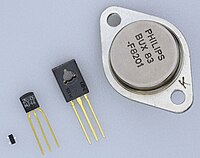
Photo from wikipedia
We carry out the physical modeling of the light emitting transistor (LET) operation with the focus on the carrier lifetime in the base, which is a key factor in the… Click to show full abstract
We carry out the physical modeling of the light emitting transistor (LET) operation with the focus on the carrier lifetime in the base, which is a key factor in the device speed performances. Our model is based on the observation of the degradation of the base transport factor caused by the LET heavy base doping and its variation with the base current. We revise the conventional charge control model of the bipolar junction transistor to account for these features and assess the concentration of the base minority carriers captured in the quantum wells (QWs). Our approach based on the Zhang and Leburton (Z-L) rate equation model enables us to obtain the device microscopic parameters, such as the capture time, the base lifetime and the base transit time in terms of the LET emitter current and the base current, as well as the design parameters such as the doping concentration, the base width, the QW width and number, and their location. Whereas the base recombination lifetime can be estimated to be of the order of a fraction of a nanosecond, the QW capture time is found to be of the order of a picosecond or less. Our simulation results agree well with the LET optical frequency response obtained experimentally.We carry out the physical modeling of the light emitting transistor (LET) operation with the focus on the carrier lifetime in the base, which is a key factor in the device speed performances. Our model is based on the observation of the degradation of the base transport factor caused by the LET heavy base doping and its variation with the base current. We revise the conventional charge control model of the bipolar junction transistor to account for these features and assess the concentration of the base minority carriers captured in the quantum wells (QWs). Our approach based on the Zhang and Leburton (Z-L) rate equation model enables us to obtain the device microscopic parameters, such as the capture time, the base lifetime and the base transit time in terms of the LET emitter current and the base current, as well as the design parameters such as the doping concentration, the base width, the QW width and number, and their location. Whereas the base recombination lifetime can be estimated to be of the ord...
Journal Title: Applied Physics Letters
Year Published: 2018
Link to full text (if available)
Share on Social Media: Sign Up to like & get
recommendations!